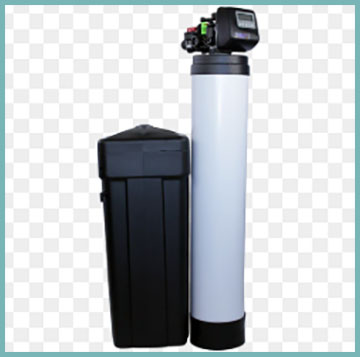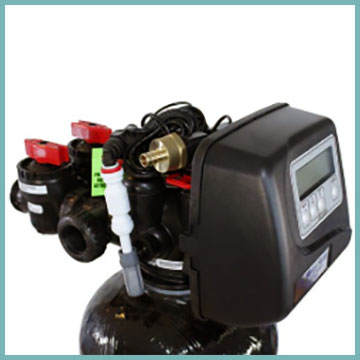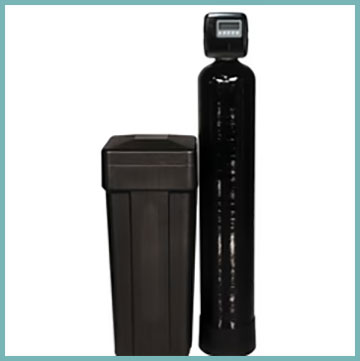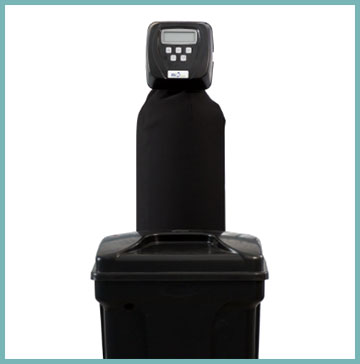If you’re battling hard water in your home, the Clack WS1 water softener is a game-changer you need to consider. I’ve lived with the frustration of limescale buildup, dry skin, and fading clothes, and this system has transformed my daily life.
Its reliable valve technology, high-capacity resin, and user-friendly design make it a standout choice for softening water effectively. Whether you’re a homeowner tired of scale on your faucets or looking to protect your appliances, the Clack WS1 offers a robust solution. Trust me, this is an investment worth making for cleaner, softer water.
My Experience With Clack WS1 Water Softener

When I first moved into my current home, the water was so hard it felt like I was showering with liquid rocks. My skin was constantly dry, my dishes had white spots, and my washing machine was starting to show signs of limescale buildup. After some research, I decided to install the Clack WS1 water softener, and let me tell you, it’s been a revelation. The installation process was straightforward, thanks to the system’s intuitive design and the detailed manual provided. I opted for professional installation since plumbing isn’t my forte, but the technician commented on how easy the Clack WS1 was to set up compared to other systems he’d worked with.
Once the system was up and running, I noticed a difference almost immediately.
The water felt silkier, and my skin wasn’t as irritated after showers.
My coffee maker, which used to clog up with scale every few months, has been running smoothly for over a year now.
The Clack WS1’s metered regeneration system is a standout feature for me—it only regenerates when necessary, based on my household’s water usage, which saves on salt and water.
I have the WS1EE model, which offers flexible programming, and I’ve tweaked the settings to match my family’s needs.
The control panel is user-friendly, with a clear display that shows when the next regeneration cycle is due.
One thing I didn’t expect was how much softer my clothes would feel after washing. The Clack WS1 uses a high-capacity 10% crosslink resin, which does an excellent job of removing calcium and magnesium ions.
I’ve also got a bit of iron in my water—around 2 mg/L—and the system handles it well, though I did pair it with a small sediment filter for extra protection. The only hiccup was learning to keep the brine tank stocked with salt, but the system’s efficiency means I’m not refilling it as often as I feared.
Overall, my experience has been overwhelmingly positive, and I’m thrilled with how this softener has improved my home’s water quality.
Read More: My Thoughts On Green Fusion Water Softener
Pros Of Clack WS1 Water Softener
- High-efficiency metered regeneration: The Clack WS1 uses a smart metering system that triggers regeneration based on actual water usage, not a rigid schedule. This means I’m not wasting salt or water, which keeps operating costs low and makes the system more environmentally friendly. It’s a relief knowing I’m only using what I need.
- Durable and reliable valve design: The WS1 control valve is built like a tank, made from Noryl thermoplastic, which resists corrosion and handles high flow rates up to 27 gallons per minute. I’ve had zero issues with leaks or malfunctions, and professionals praise its longevity.
- Customizable programming: With the WS1EE model, I can fine-tune settings like regeneration cycles and backwash frequency. The front-panel controls are intuitive, and the system stores my preferences even during power outages, thanks to a coin-cell battery backup.
- High-capacity resin: The 10% crosslink Aldex resin is a powerhouse, capable of softening water with hardness levels up to 120,000 grains. This is perfect for my household, where we have moderately hard water, and it ensures consistent performance over time.
- Versatile sizing options: The WS1 comes in various tank sizes, from 0.75 to 3.0 cubic feet, so I could pick one that fits my family of four. Whether you’re in a small apartment or a large home, there’s a model that works.
- Low maintenance needs: Beyond refilling the brine tank, the system requires minimal upkeep. I clean the valve stack with citric acid every six months, and it’s been smooth sailing. This ease of maintenance saves me time and hassle.
The Clack WS1’s efficiency and durability make it a standout. The metered regeneration alone has saved me money on salt, and the customizable settings let me tailor it to my needs. It’s not perfect—no system is—but these strengths make it a top contender for anyone dealing with hard water.
Cons Of Clack WS1 Water Softener

- Limited online availability: Buying a Clack WS1 can be a headache because Clack restricts online sales. I had to go through a local water treatment specialist, which added a layer of complexity. If you prefer the convenience of online shopping, this could frustrate you.
- Professional installation recommended: While the system is designed for easy setup, Clack’s policy pushes for professional installation. I paid extra for this, and while it was worth it for peace of mind, DIY enthusiasts might feel restricted.
- No built-in filtration for contaminants: The WS1 is fantastic for softening water but doesn’t remove bacteria, heavy metals, or other contaminants. I needed a separate sediment filter for iron, which added to the overall cost.
- Initial cost can be high: Depending on the model and grain capacity, the Clack WS1 can be pricier than some competitors. My 1.5-cubic-foot system wasn’t cheap, though the long-term savings on maintenance and efficiency offset the upfront hit.
- Salt monitoring requires attention: The system doesn’t alert you when salt levels are low unless you opt for an EZSalt sensor, which isn’t always included. I’ve forgotten to check the brine tank a couple of times, leading to a temporary dip in performance.
- Programming can feel complex initially: While the WS1EE’s customization is a pro, it took me a few tries to get the settings right. If you’re not tech-savvy, the array of options might feel overwhelming at first.
These drawbacks don’t overshadow the WS1’s strengths, but they’re worth considering. The limited availability and need for additional filtration were my biggest gripes, but once installed, the system’s performance made up for the initial hurdles.
Maintenance Tips For Clack WS1 Water Softener

- Regularly check and refill the brine tank: I make it a habit to check the salt level in the brine tank every month. Keeping it at least one-quarter full prevents salt bridging, where a crust forms and blocks water flow. I use high-purity sodium chloride pellets for best results.
- Clean the valve stack periodically: Every six months, I clean the valve stack with citric acid to remove any iron or mineral buildup. It’s a simple process—remove the stack, soak it, and reassemble. This keeps the system running smoothly and extends its lifespan.
- Inspect the resin bed annually: The resin bed is the heart of the softener, so I check it yearly for fouling or degradation. If you have high iron levels, like I do, consider adding a resin cleaner during regeneration to maintain efficiency.
- Schedule professional servicing: I have a water treatment specialist check my system every two years. They inspect the seals, spacers, and piston for wear, ensuring everything’s in top shape. This proactive approach prevents costly repairs down the line.
- Monitor water quality: I test my water’s hardness and iron levels every few months using a home test kit. This helps me confirm the WS1 is performing as expected and lets me adjust settings if my water conditions change.
- Keep the system powered: The WS1’s battery backup is great, but I ensure the 15-volt DC power supply is always connected. A stable power source prevents disruptions in the regeneration cycle and keeps the system’s memory intact.
Maintaining the Clack WS1 is straightforward if you stay consistent. These steps have kept my system running like new for over a year, and I’ve avoided any major issues by being proactive. A little effort goes a long way in ensuring soft water for years.
Comparison With Other Brands

- Fleck 5600SXT:Fleck’s 5600SXT is a popular alternative, and I’ve seen it installed at a friend’s house. Its digital interface is sleek, with Bluetooth connectivity that lets you adjust settings from your phone, which is a nice touch I wish the Clack WS1 had. The 5600SXT also handles high flow rates, up to 20 gallons per minute, making it suitable for larger households. However, its programming is less flexible than the WS1EE’s, with fewer regeneration cycle options. I found the Fleck’s resin tank slightly less durable, as my friend had to replace seals sooner than I did with my Clack. The 5600SXT is often more affordable and easier to find online, which is a big plus if you’re on a budget or prefer quick purchases. Still, the Clack WS1’s robust valve and higher flow capacity (up to 27 gallons per minute) give it an edge for heavy-duty softening needs.
- SpringWell SS1:The SpringWell SS1 is another contender I considered before choosing the Clack WS1. It’s marketed as eco-friendly, using less salt and water during regeneration, which appealed to my green side. Its digital control head is user-friendly, with a clear display similar to the WS1’s. However, the SS1’s grain capacity tops out at 80,000, while my Clack WS1 handles up to 120,000, making it better for very hard water. The SpringWell also includes a pre-filter for sediment, which I had to buy separately for my Clack. On the downside, the SS1’s installation was more complex, according to online reviews, and its price is comparable to the WS1’s, but without the same level of programming flexibility. I prefer the Clack’s versatility and proven valve reliability over the SpringWell’s bells and whistles.
- Aquasure Harmony Series:The Aquasure Harmony Series caught my eye for its all-in-one design, combining softening with carbon filtration for chlorine removal. This is a big advantage over the Clack WS1, which focuses solely on softening. My neighbor uses the Harmony, and he loves how it improves water taste alongside softening. However, its flow rate is lower, around 15 gallons per minute, which could be a bottleneck for larger homes like mine. The Harmony’s resin is high-quality but not as robust as the Clack’s 10% crosslink Aldex resin. Availability is also a plus for Aquasure, as it’s sold online more readily than Clack systems. Still, the WS1’s durability and customization options make it a better fit for my needs, especially with my high iron levels.
Each brand has its strengths, but the Clack WS1’s combination of durability, high capacity, and programming flexibility won me over. If you need filtration beyond softening, Aquasure or SpringWell might edge out, but for pure softening power, Clack is hard to beat.
Read More: My Thoughts On Nelsen Water Softener
Frequently Asked Questions (FAQ)
The Clack WS1, or rather the valve and components used in systems like the Pro Series WS100, typically lasts 15 to 20 years with proper maintenance. The valve itself is built from durable Noryl thermoplastic, and the resin bed can last a decade or more if cleaned regularly. My system’s been running strong for over a year, and professionals I’ve spoken to say consistent upkeep—like cleaning the valve stack and monitoring resin health—extends its life significantly. Harsh water conditions, like high iron, can shorten the resin’s lifespan, so pairing it with a sediment filter helps.
Plumbers often recommend systems with reliable valves and high-efficiency designs, like Clack WS1, Fleck 5600SXT, and SpringWell SS1. I’ve talked to local technicians who praise Clack for its robust valve and easy servicing, especially the WS1EE model. Fleck is another favorite for its affordability and digital interface, while SpringWell gets nods for eco-friendly operation. The choice often depends on your water conditions—Clack shines for high hardness, while others might suit combined filtration needs. Always consult a local expert to match the system to your water quality.
It depends on your priorities. I chose the Clack WS1 for its higher flow rate (27 gallons per minute versus Fleck’s 20) and more programmable regeneration cycles, which let me tailor it to my household’s needs. Clack’s valve feels sturdier, and its double backwash keeps the resin cleaner. However, Fleck’s 5600SXT is easier to buy online and has a slicker interface with Bluetooth. For heavy-duty softening, I lean toward Clack, but Fleck’s a solid choice for smaller homes or tech enthusiasts.
There’s no one-size-fits-all answer, as it hinges on your water hardness, household size, and budget. I went with Clack WS1 for its durability and high grain capacity, perfect for my hard water woes. Fleck offers great value and ease of access, while SpringWell appeals to eco-conscious users. Aquasure’s Harmony Series is ideal if you want filtration too. Based on my experience and research, Clack stands out for reliability and performance, but testing your water and consulting a professional will point you to the best fit.
Conclusion: For Clack WS1 Water Softener
If hard water is wreaking havoc in your home, the Clack WS1 water softener is a reliable, high-performing solution you should seriously consider. Its efficient regeneration, durable valve, and customizable settings transformed my water quality, making showers, laundry, and appliance maintenance so much easier.
Despite some challenges, like limited online availability, the WS1’s benefits far outweigh the drawbacks. For anyone seeking soft, scale-free water and long-term value, this system delivers. Don’t let hard water hold you back—invest in the Clack WS1 and feel the difference.
